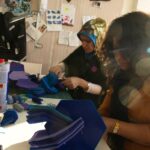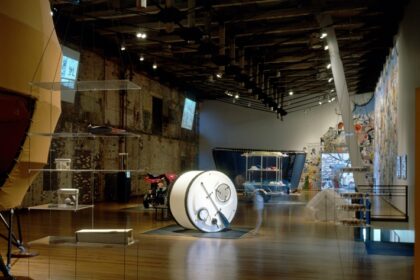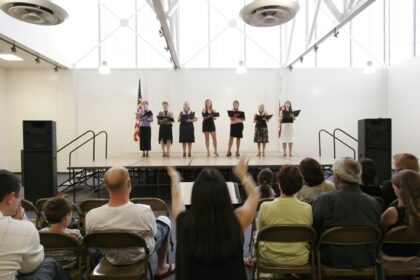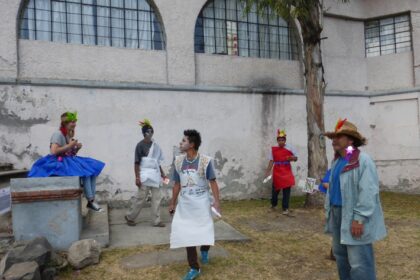Thoughts On the Cultural Policy of a Failed State
Marc Herbst
As a co-editor of the Journal of Aesthetics & Protest, I found out about my interest in “social practice” alongside the field’s emergence. Our journal’s conceptualization was concurrent with the globalization movement of the late 1990s and saw the convenient overlaps between art, 90’s anarchism and new media culture as politically useful. Coming out of a D.I.Y. anarchist tradition whose key text was Hakim Bey’s T.A.Z., a book that romantically theorized moments of ahistorical carnivalesque—we had no methodology besides an eye to the times. Symptomatically, Nicholas Bourriaud’s “relational aesthetics” floated in like an occasional friend who’d arrive with invites to exclusive parties. For the most part, the motivation for our merging of all sorts of social technologies in a manner favorable to a small section of the art world was purely political. “How can we describe the juncture of fine art and anti-authoritarian activism in order to make a more joyous, livable and equitable world?”[1]
In America, its not uncommon for either artists or activists to experience their journey as an act of self-creation; that’s clearly how the Journal experienced it. Because socialization in both the worlds of activism and art are very generation-specific, they inhabit worlds that perhaps appear entirely self-made. Yet these “worlds” are structured from both outside and inside by larger historic and material forces. Though the long-term success within the arts of an artist run space relates to how its participants arrange relationships with capitalism, this is a greater shibboleth than gentrification. Within activism, the post ’68 trend of “culturally based”[2] organizing outside the traditional structures of unions and parties has only increased. Witness for example the success of the Occupy Movement, initiated in absentia by the subvertising journal, Adbusters. While histories and solidarity are always important to purposefully bohemian political artists and organizers, our event-oriented constitutional formations unevenly occlude and highlight things so that whose history and which solidarities are rarely settled facts.
For these reasons, I’ve been interested in the printed detritus of East German cultural policy. It struck me soon after moving to Leipzig, Germany, that I was living in the remains of a society that had made a conscious effort to order and structure life based on some of the intellectual legacies I’d originally learned about in poorly attended art history lectures; Kant, Hegel, Marx among others. At its best, East Germany appears as a state that intelligently prioritized the social formations of the working class, where an average factory worker could earn a better salary than an academic.
What follows is a photo essay gathered from a collection of East German books in order to reflect something on contemporary politically oriented social practice art. The reflection uses this near-foreign system as a mirror on the tensions between ideology, material reality and its social relations, creative autonomy and the bare life. This reflection relies on the imaginable malleability of the social sphere, that the specificity of human arrangements are just that—important specifics. As such, bare life is that which is irreducibly necessary for survival, the social practice is seen as the necessary and generous creativity of and beyond this.
Social practice has two separate meanings; it is both the day-to-day practice of living (socially) and also a practice of engaging social techniques. The social is bound within this duality, between the necessity of day-to-day living and the teleologies of conscious productions.[3] The ways in which societies exist within themselves while aiming to structure themselves inherently affect all forms of organized cultural relations. Contemporary social practice art is one conscious form of cultural production that plays with and/or attempts to institute alternatives and expansions on social existence. It falls within the inherent cultural policy of neoliberalism by, in effort if not goal, supporting the narrative of the autonomous subject.
Because social practice innately utilizes material and participants from its immediate contexts, social practice as itself and as an art has a high level of regional variation. The variations mirror each region’s political economy, institutional support for socially creative innovation, and the strength of autonomous social movements that also utilize social practices in order to reorder life in a variety of manners.
East Germany (the DDR or Deutsche Demokratische Republik) forwarded a socialist practice as state policy that was utilized to produce certain effects. With limited means, the state produced a highly industrial society and labor force that heavily utilized the country’s natural resources. It provided cradle to grave welfare that promised and delivered no unemployment or hunger. Its cultural and intellectual spheres were policed in a manner and atmosphere I can hardly imagine. In comparison, contemporary Western social practice arts emerge in an era with seemingly limitless cultural freedom but little economic safety.
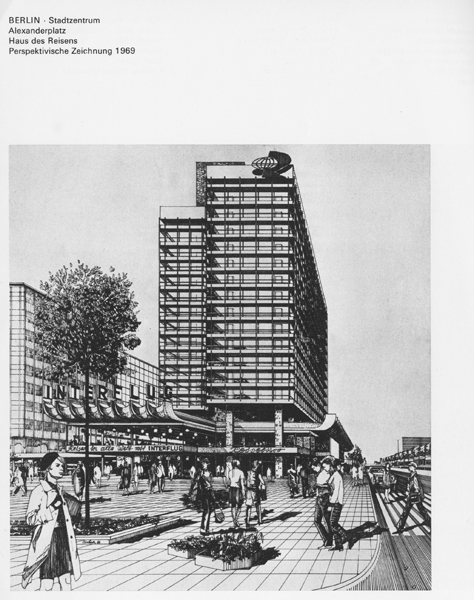
Socialist policy of the East German state made clear its intentions by providing clean, modern and well-planned housing. The pre-fab panel-built “plattenbau” starkly contrasted the deteriorating pre-war urban constructions. Edge-city plattenbau towns were serviced with all the modern conveniences including the full range of childcare that was necessary for a state that assumed full employment for its citizens. Anecdotally, I’ve heard of one person whose family had economic troubles in the early East German era—soon after the war. After the mid-sixties, it’s difficult to find examples of structural poverty within the system.
By the 1970s East Germany’s economy was the strongest of the Eastern Block. With political allegiance to the Soviet Union and its brand of Marxist-Leninism, East Germany was a multiparty state with the SED (Socialist Unity Party) made structurally dominant. The SED ran a planned economy whose ideology was organized under the notion of an “actually existing socialism.” This actual existence of socialism rested in and was dependent upon the social and economic practices of both the state and its citizenry. This actuality provided the allowance for the uneven distribution of social relations, ideological formations and material realities under the assumption that as socialists, the society as a whole was moving ever closer towards the utopia of socialism.
Within East Germany, though ring-city plattenbau developments were considered healthier because of access to sunshine and fresh air, historic urban cores were not completely abandoned. Architecture books discussed the need to preserve urban life and also build working monuments to culture (in the form of museums, opera houses, universities, and skyscrapers) as living monuments to the historic role played by Germany’s revolutionary working class.
The above image is an architectural rendering of the East German Tourist Agency Building’s main offices in Alexanderplatz, East Berlin. From this or other offices throughout the DDR, most citizens could afford to book holidays to the Black Sea, Bulgaria, and other travel destinations.
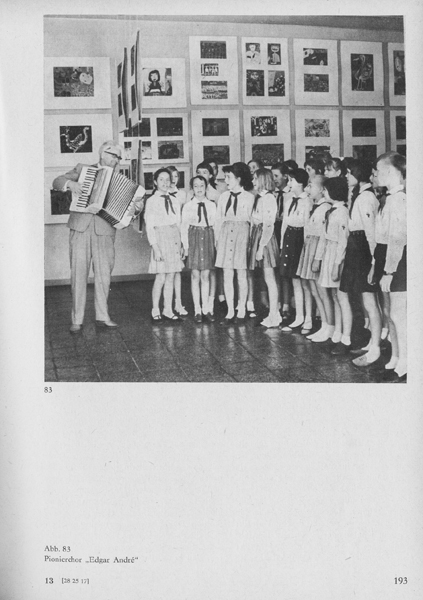

“Immer Bereit”—always ready for peace and socialism. This was the motto of the Young Pioneers, the SED’s youth group also known as the FDJ (Free German Youth). Through the Young Pioneers and other extra-governmental organizations (though party-affiliated, there existed a division between the party and the government), socialism organized a rich array of cultural activities. To access after-school’s rich social life, one often had to enroll in the Young Pioneers. Children’s relative autonomy from their parents was afforded by the array of activities offered to them within a socialist living structure made safe for childhood. Kids had a lot of options; sports, music, travel, clubs. Even today a friend’s child enjoys piloting ultralight airplanes made at an amateur airfield whose airplanes and runway are the legacy of state sponsored forms for popular recreation. Many people describe the socialist world of their childhood as rich in time, safety, creativity, craft, and sport.
Gabriele Stötzer is a DDR era dissident performance artist and writer who responded to the inherent patriarchy of the state whose public space was functionalized for production. The governing regime’s disinterest in the subconscious was made palpable for her in the industrial landscape of mass social formations the state created. As the state provided few methods of personal exploration (Freud and the subjective tools of the Western counterculture were pedagogically shunned), her artwork first became a tool for self-exploration. Her performance videos have her tentatively exploring her own naked potential on the roof of a plattenbau.
Though Stötzer served one year in prison for signing a letter criticizing the government’s expulsion of a folk singer to West Germany, she remained within the DDR with a dissident status. Unable to legally display artwork in sanctioned galleries, her work circulated in underground networks, though she primarily shared her projects with a tight-knit feminist circle. Ultimately, her extended collective was able to organize the first occupation of a State Security (Stassi) office at the time of The Wall’s crumbling. The occupation and immediate preservation of this office’s documents helped ensure the collapse of East Germany’s pernicious Stassi. Stötzer has since become an author, journalist and occasional commentator.
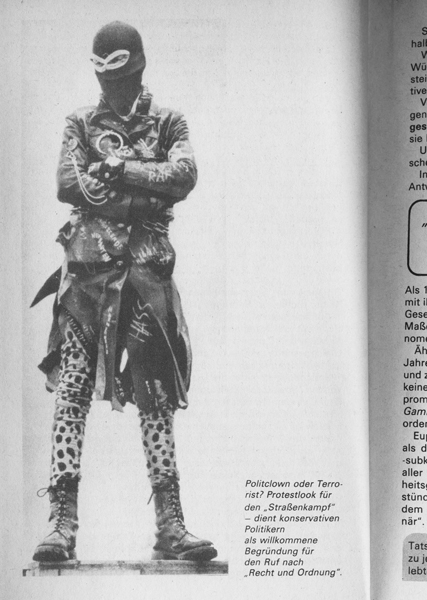
This is an image from a popular book series Konkret published by the FDJ youth group. This particular issue looks at Western youth movements with a paternally empathic yet critical eye. The text makes an effort to empathize with and explain Western rebel youth; hippies, punks, fashionistas. Editorially, the text always falls on the side of governmentality. As the caption states, “Political clown or terrorist? Protest look for the street fighter—it provides Conservative Politicians with a welcome reason to call for ‘law and order’.”
When I showed the book to a friend who grew up in the DDR, he was incredulous. He couldn’t believe that the book was published in East Germany. “If I’d seen this when I was a kid, I’d have been all over these pictures. The text would have meant absolutely nothing to me.” Occasionally, the FDJ did act independently of the government; the Konkret issue on the environment was censored for having too strident a stance on pollution.

This is the 1979 Cultural Calendar for the Bad Liebenwerda region. Bad Liebenwerda is a rural region with a small health spa. The first few pages of the Kulturangebot are dedicated to clarifying the role that cultural workers play in society, also explicating the rights of musicians, artists and the fees they will receive for services.
From my American perspective, the Kulturangebot has such provocative sounding offerings. It lists the schedule and meeting locations for the Soviet-German friendship club, the woman’s club, the workman’s club, the sewing club, the socialist farm worker’s club, in addition to other highlighted offerings including the annual teen disco. Yet its content must have been and appears to be so incredibly mundane. I appreciate the booklet’s high print quality and its Picasso-inspired modernist abstractions mixed with a disco era graphic sensibility. I’m assuming the people of Bad Liebenwerda appreciated the touch of style too.
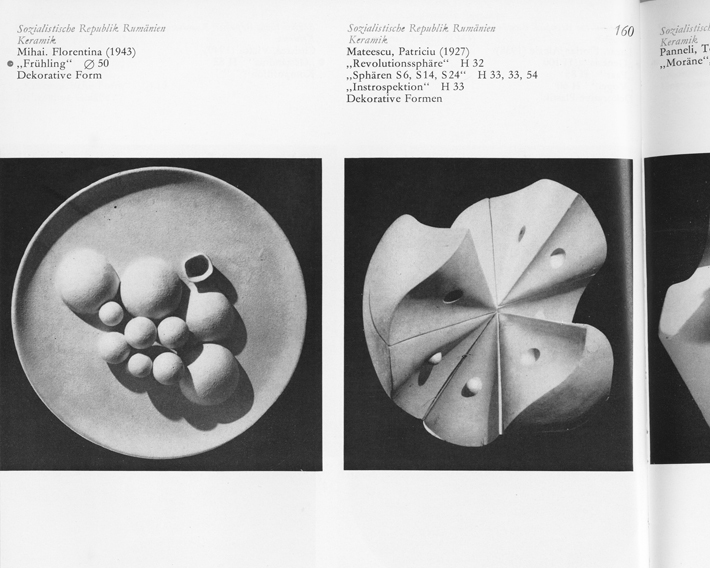
From the First Quadrennial for Arts and Crafts of the Socialist Countries. What impresses me about this internationalist quadrennial (including Vietnam and the East Block) is how the formal artworks’ titles flow between ideologically infused and the poetic. “Spring” and “Revolutionary Phase.” Both are time-based names impressed upon uniquely formed objects—here ceramic plates.
If a territory’s official policy is the granting of its citizens the social practice of enacting socialism over time, how does the formalization of the process square against reality? With the socialist norm set at the mass spectacle of the May Day parade, how might a more meaningful performance of socialism ingratiate itself over time?
As a non-disruptive object speaking in coded and symbolic language, these pieces serve as reminders and references for possible becoming. Much dissident artwork (of which the above is not representative) also spoke in similarly coded language—for to directly critique the state in objective form would serve well in court as evidence. After reunification, much of Eastern Germany’s newly emergent and popular antifascist youth scene took an apolitical turn. Like the West, creative activist culture more openly embraced the representational politics of inclusion without maintaining a concurrent focus on privatization and sudden income inequality.
Though consciously leftist, an acquaintance of mine found himself a young East German dissident by actively questioning in school the mass-society youth forms. As pastors in the Lutheran Church, his parents drew from disobedient practices that predated the East German State, and his behavior prioritized a community of consciousness[4] and isolated him from his school peers. Socially isolated, his behavior got him on his teachers’ watch lists. As he grew into a teenager, his small group of friends, in a creative punk spirit, began incorporating fabric artworks into their clothes. They détourned hats, shirts and pants with wildly colorful fabric swatches and superfluous threading. They were among a very small group of political disobedients in the town. They had a rough time.
East Germany collapsed when the protests of Leipzig’s disobedient Left organized with the help of the church became general throughout the autumn of 1989. After reunification, a popular left expanded through electronic music and punk rock. My friend went another route, finding institutional support through previous dissident connections. He currently works as a teacher, with a radical pedagogy aimed at strengthening public commons by establishing more meaningful connections to a socialist imaginary that does not deny the individual subjectivity. No longer politically censored, he remains isolated from the general flows of the mainstream left because there exists little interest in the former East for re-imagining possible forms for the common management of human affairs. Rather, like elsewhere, the mainstream activist left in Germany is primarily interested in anti-racist activism that ultimately ensures access to the state’s/capitalism’s reproductive machinery.
East Germany forwarded a socialist ideology through particular, though broad infrastructures that produced the social practice it named “socialism.” This practice of socialism re-enforced the state, until the moment it no longer did. What emerged afterwards, like elsewhere, is the social practice of neoliberalism. How do the conscious and secondary social productions of our current state work through the entirety of its social systems? What institutional structures allow for the development of this neoliberal personality? What material relations does this personality facilitate? What ideas and social practices exist that are truly or partially outside of state interests? How do these counter-formational practices circulate in our system? What are the time frames and social constitutions necessary for their meaningful circulation? That is, in what manner and in what time does any idea achieve actual results? How do those results vary depending on context and time frames?
Social practice can be understood as the continued effective constitutional movement of a coherent set of ideas that are indistinguishable from their practice (in other words, practices within the practice of living). What is the nature of the objective forms that are naturally produced from this practice of living; as stories, words, objects, images, scripts?
Art and activism’s contemporary social practices are primarily based around the circulation of image/ideas intended as connections to better worlds. How operative are these image/ideas when removed from the context that forge them in practice? A comparison between East Germany and contemporary political practice has me considering the wiggle room between an ideology, its social practice and the burden of what that ideology disallows for. Ultimately Socialism was best expressed through infrastructure (in platters and plattenbau) for even today they continue the affirmative material legacy of the era. The individual, even the socialist individual, had a messy and unfulfilling experience in the social practice of the DDR. The proof for this is the fact of the events of “die wende”—the change from two Germanys to one, that was instigated by individual participation in micro and macro-political acts such as occupations of offices and participation in mass protests.
Micro-histories within former regimes demonstrate the eventual affectivity of resistance but can hardly explain their general outcome because the difference in scale between the historical actor and a historic act is huge. Socialist social practice made that difference in scale obvious by actively marginalizing people. Contemporary social practice normatively suggests that everyone’s abstracted creativity matters. Contemporary politically oriented social practitioners (in activism and art) would do well to consider the varied, unequal yet unpredictable capacity of differently constituted actors (as individuals, grassroots groups, conceptualizations, material structures, institutions) to work in a variety of ways between disobedience and deference to produce real effects.
Marc Herbst is co-editor of the Journal of Aesthetics & Protest (Joaap), a journal and art collective founded in 2001 in Los Angeles, California. Joaap is described at times either as “a weirdo think-tank” or a “journal that meets at the intersection of fine art, media theory and the globalization movement.” Herbst is an artist, writer, organizer and currently a PhD student at the Centre for Cultural Studies at Goldsmiths. He used to trust the criminal element in his garden but now has no garden and is interested in listening at the space between senses and words, between finding a shelter, and playing cards. He enjoys drawing comic books and doing performance workshops. With the Journal or alone, he has taught, presented work and/or lectured at the Universities of California, Yale University, Malmö Kunstacademie, the New Museum (New York), KPFK radio, Galerie für Zeitgenössische Kunst Leipzig, The Field, Electrodomestica, Medionauta, and elsewhere.
Notes
[1] This quote is a play on how we occasionally describe the Journal of Aesthetics & Protest’s mission.
[2] “Culturally based” organizing here is put in quotes to suggest the inorganic nature of the term. One should be reminded that all organizing is ultimately “culturally based” in that the nature of human organizing involves collecting subjectivities via performative organizational models. Party and union politics, and to a lesser extent race-based politics are read as traditionally “political” and not “cultural” to the extent that the interests motivated through these forms have been rationalized into pre-existing political arrangements.
[3] Conscious production here is defined as the purposeful and professional designing and making of things, whether they are objects (such as artworks or chairs) or the identified ideas and procedures that are understood to underlie or surround these things.
[4] His parents were pastors involved in a historically disobedient tendency within the Lutheran Church.


